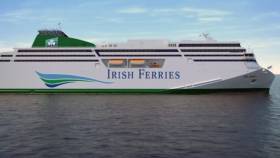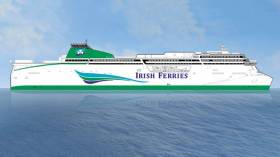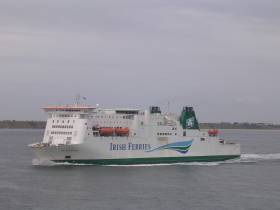Displaying items by tag: Irish Ferries
€7m Bill Faces Irish Ferries for Cancelling French Services
#FerryNews - A bill of up to €7 million faces Irish Ferries for cancelling scheduled French services following delays by a German shipbuilder in finishing a new craft for the company.
The ferry operator writes The Irish Times, was forced to cancel sailings of its new ship, the WB Yeats, from Dublin to France, beginning on July 30th, because its builder, Flensburger Schiffbau-Gesellschaft (FSG), had told the Irish firm that the craft would not be ready on time.
Industry analysts at stockbrokers Goodbody and Investec calculated that the cancellations, along with the resulting compensation and rebooking of passengers on alternative services, could cost €4.5 million.
Eamon Rothwell, chief executive of the ferry company’s parent, Irish Continental Group, recently estimated that earlier cancellations, also resulting from FSG’s failure to finish the WB Yeats on schedule, would cost €2.5 million.
As a result, the delay in finishing the WB Yeats leaves the shipping group facing extra costs of €7 million at its busiest time of year.
To read more on this story, click here.
As previously covered on Afloat the newbuild cruiseferry had originally been scheduled to launch sailings earlier on July 12th, click related report here.
#FerryNews - Ulysses, Irish Ferries cruiseferry on the Dublin-Holyhead route has sailings cancelled today (2 May) and up to Friday (4 May).
According to the operator's website this is due to technical reasons. All of the cruiseferry's operated sailings in both directions on the Ireland-Wales route are cancelled.
Passengers instead can be accommodated on the route's fastferry, HSC Dublin Swift and the ropax ferry Epsilon.
For updated sailing information click the link here and also for contact details.
The 50,938 gross registered tonnes flagship Ulysses is the largest ro-ro ferry operating on the Irish Sea. Since introduction in 2001, the cruiseferry has held a strong reliable track record of service maintaining the core short-sea route.
The cruiseferry is no longer docked at Dublin Ferryport Terminal 1 having proceeded upriver to berth in Alexandra Basin.
Irish Ferries Former 'First' Fast Ferry Jonathan Swift Departs On Delivery Voyage to the Mediterranean
#FerryNews - Irish Ferries former first fastferry, Jonathan Swift departed Dublin Port today under new name Cecilia Payne for Spain, a day after a larger replacement craft Dublin Swift took over Dublin-Holyhead sailings, writes Jehan Ashmore.
In January Irish Continental Group (ICG) parent company of Irish Ferries announced that it was to sell the high-speed craft (HSC) to Balearia Eurolineas Maritimas S.A. for an agreed consideration of €15.5 million.
Jonathan Swift is an Austal-Auto Express 86m catamaran which spent a career spanning almost two decades on the core Ireland-Wales route when launched into service in 1999. The 800 passenger/200 car catamaran built by Austal Ships Pty, Australia, became the first fast-ferry ordered by ICG.
At a ceremony in 1999 held at Dublin Ferryport Terminal 1, the high-speed craft (HSC) Jonathan Swift was christened by Cecilia Larkin, then the partner of then Taoiseach Bertie Ahern.
During the past 18 years, the craft marketed as the 'Dublin Swift' operated crossings in just 1 hour 49 minutes. When introduced, the HSC operated alongside cruiseferry Isle of Inishmore which was replaced in 2001 by larger conventional tonnage in the form of Ulysses. In more recent years the flagship was joined by the chartered-in ropax Epsilon.
Departures today of both HSC took place in the afternoon and around ten minutes appart from the capital. This involved Dublin Swift (ICG acquired in 2016 and subsequently chartered overseas), first to pass the Kish Bank Lighthouse and bound for Wales. Astern, Cecilia Payne likewise set a similar course until rounding the lighthouse and then headed for the Bay of Biscay. The next port call is La Coruña in Galicia, northern Spain and eventually the Mediterranean where new owners Balearia await delivery.
When Cecilia Payne debuts in the Mediterranean on 1 June, it is thanks to the 35 knot capable catamaran that reduced sailings times will be made available on two routes: The Dénia (mainland)-Ibiza route and Ibiza-Palma, each taking only 2 hours to complete.
The craft's name of Cecilia Payne has been chosen by Balearia in recognition of the famous Anglo-American astronomer and astrophysicist. She was honoured for her work on the stars and as the first woman to teach at the famed Harvard University.
#FerryNews - Completing a maiden high-speed craft (HSC) crossing on Irish Ferries Dublin-Holyhead route this morning is Dublin Swift, replacing a smaller craft that has served for almost two decades, writes Jehan Ashmore.
The Dublin Swift docked in Holyhead this morning just after 11.00.
The newcomer takes over from HSC Jonathan Swift which has operated since 1999 on the core Irish Sea route. The car-carrying catamaran becomes the largest fast-ferry on the Irish Sea and has entered service in the shoulder season in advance of the busy high-season months on the Ireland-Wales link.
Dublin Swift operates at 35 knots to maintain the same frequency of sailings with twice daily return crossings likewise to the replaced Jonathan Swift. ICG sold the fastferry to Spanish operators to serve a career in the Meditteranean linking the Balearics.
Prior to introduction, Dublin Swift underwent a refurbishment programme in Belfast following a charter overseas, so to bring the HSC up to Irish Ferries standards for 820 passengers and space for 200 vehicles. Onboard facilities are located on one deck, compared to the double deck arrangment on Jonathan Swift.
The facilities of Dublin Swift include a dedicated TV Snug, cafeteria, self-service restaurant and games area.
Passengers have a selection of spacious seating accommodation in the standard cabin, or plush reclining seats with views to sea, in-seat recharging points and complementary refreshments in the Club Class Lounge. This area of the fastferry is positioned at the bow. Free Wi-Fi is offered throughout.
The HSC brings increased capacity on the core Irish Sea route also operated by flagship Ulysses and ropax Epsilon.
The 8,403 gross tonnage Dublin Swift, (formerly Westpac Express) was in 2016 acquired by ICG, parent company of Irish Ferries for $13.25 million. Built in 2001 by Austal Ships Pty to their in-house 101m Auto-Express design. The yard in Fremantle, western Australia is also where Jonathan Swift was custom built for ICG.
Dublin Swift is also the only fast ferry operating between Ireland and Britain, though the Isle of Man is served by the Steam-Packet's fastferry Manannan on seasonal routes including the Dublin link.
#FerryNews - Operator Irish Ferries has confirmed that in the region of 5,000-10,000 customers will be affected by cancelled bookings on a new ferry, the delivery of which has been delayed.
The company writes The Irish Times, continued to make contact with booked passengers on Sunday, said it did not have an exact figure for numbers impacted at this stage.
A spokesman for Irish Ferries said that less than 10,000 passengers are impacted by the cancellations. “It is under 10,000, somewhere in the 5,000-10,000 segment,” he told The Irish Times on Sunday.
In a statement, the company said it cancelled a number of sailings from July 12th-29th as the German shipyard building the new vessel, the WB Yeats, informed Irish Ferries her delivery “is likely to be delayed”.
The company emailed affected passengers late on Friday evening stating that while the delay had yet to be “fully confirmed by the shipyard we have, in the interests of minimising the level of potential disruption to you, taken the decision to cancel your sailing”.
To read more including refunds for affected customers, click here.
#FerryNews - Holiday plans of thousands of families travelling to France this summer have been thrown into disarray after Irish Ferries cancelled bookings on its new WB Yeats ferry scheduled to depart in July, writes The Irish Times.
In emails sent to affected passengers late on Friday evening, the company’s managing direct Andrew Sheen said it had “just been informed by the German shipyard building the WB Yeats, the ship on which you are currently booked, that her delivery to Irish Ferries is likely to be delayed.”
He said while the delay has yet to be “fully confirmed by the shipyard we have, in the interests of minimising the level of potential disruption to you, taken the decision to cancel your sailing. We will contact you and offer you a space we have held for you on the MV Oscar Wilde close to your booked sailing date.”
The email correspondence said that n the absence of an acceptable alternative passengers will be entitled to a full refund.
To read more on the delays of the €150m newbuild cruiseferry, click here.
#FerryNews - Irish Ferries soon to be introduced high-speed-craft Dublin Swift which since January has been in Belfast for a major refurbishment arrived in Dublin Port last night, writes Jehan Ashmore.
Afloat monitored Dublin Swift when offshore of Co. Down late yesterday afternoon and at time of writing, the HSC catamaran is docked in Dublin Port at the ferryport's berth 51A. This berth is where the current HSC, Jonathan Swift maintains operations on the core Dublin-Holyhead route until as previously reported is to be disposed later this month.
A year ago this month Irish Continental Group (ICG) parent company of Irish Ferries acquired the HSC for $13.25 million. The HSC was placed on an external-charter by ICG for use by the US Military Sealift Command.
On completion of the charter, the HSC arrived to Belfast this day three months ago and would later receive conversion works in Harland & Wolff's Belfast Dry Dock. This was followed by a refurbishment programme to bring the craft up to Irish Ferries standards. The works also took place at H&W's Ship Repair Quay adjacent to the dry-dock.
In 2001, Westpac Express was built by Austal Ships Pty, Fremantle, western Australia, to their in-house 101m Auto-Express design. The HSC has a gross tonnage of 8,403, passenger capacity for 900 and vehicle space for 182.
Dublin Swift will bring increased capacity on the core Ireland-Wales route in partnership with flagship cruiseferry Ulysses. Likewise of the flagship, the Cypriot flagged HSC will join operations on the core Ireland-Wales link with the chartered-in ropax Epsilon providing more freight-orientated capacity.
For almost two decades Jonathan Swift has served the route. The HSC was custom-built for ICG and marketed by Irish Ferries as the 'Dublin Swift' (see: related story). On introduction of this 'second' Swift, this will led to a delivery voyage of the older HSC to Spanish operators to begin a career in the Mediterranean. This is understood to involve a Spain-Belearic service.
Returning to Belfast is where a recent arrival to the Ship Repair Quay, Azamara Pursuit is in port for a major multi-million pound refurbishment. The cruiseship which operates for Azamara Club Cruises, a brand of Royal Caribbean International, contracted Newry-based fitout specialists MJM Group for the project.
The 30,000 tonnes cruiseship had served a career with P&O Cruises with calls to Irish ports among them Cobh and followed by a short-lived service in Cuban waters.
#FerryNews - Fuel costs increased and a weaker sterling led earnings at Irish Ferries owner Irish Continental Group (ICG) to fall 3 per cent, results for the year ended December 31st 2017 show.
As The Irish Times reports, despite revenue growth of 3 per cent to €335.1 million on the back of volume growth across the group’s operations, earnings before interest, taxes, depreciation and amortisation fell to €81 million.
Company chairman John B McGuckian flagged the year as a successful one before noting group fuel costs increased by 25.2 per cent to €40.3 million.
Early in the financial year Irish Continental sold its MV Kaitaki which yielded a profit after tax of €24.9 million. Early this year the company sold its Jonathan Swift vessel.
Additionally, the company entered into an agreement this year for a new ferry, which will cost €165.2 million, that will be delivered to the group in 2020 and will be used on the company’s Dublin to Holyhead services.
Although the company’s EBITDA performance won’t thrill shareholders, it was ahead of analyst expectations while profit before tax increased by 45 per cent to €87.8 million. Additionally, the company has moved from a €37.9 million net debt position in 2016 to a net cash position of €39.6 million last year.
Irish continental operates in two divisions; the ferries division which offers passenger and roll-on roll-off freight services, and the container and terminal division.
Despite Brexit associated headwinds, the overall car market to and from the Republic of Ireland grew by around 1.7 per cent in 2017 to 807,400 cars.
Irish Ferries’ car carryings “performed strongly”, up 2.4 per cent to 424,000 cars. The company carried 1.65 million passengers in the period, up 1.7 per cent, thus outperforming growth in the wider market where numbers edged up 1 per cent to 3.13 million passengers.
For more click here.
#CruiseLiners – The cruise and ferry industries were among those gathered at the annual Irish Travel Industry Awards held in association with Aer Lingus.
The prestigious gala awards of the Irish Travel Agents Association (ITAA) ceremony took place recently in the Mansion House, Dublin, where more than 500 travel and tourism professionals from around the world attended. Adding to the glamour, broadcaster, Miriam O’Callaghan was this year's Master of Ceremonies.
Among the big winners on the night from the cruise and ferry industries, were MSC Cruises that was awarded ‘Best Main Stream Cruise Company’. This category has been dominated by Miami USA based, Royal Caribbean since the awards were inaugurated in 2011. The Italian founded Mediterranean Shipping Company are a global cruise operator based in Switzerland.
Irish Ferries took the title for ‘Best Ferry Company’ which Afloat adds is the eight-consecutive year that the Dublin based transport shipping company has won this award. Voting in this category of the annual ITAA awards that began also eight years ago, were cast by travel agents and their staff from across Ireland.
In the overall ITAA awards, Manning Travel, who are based in Kilkenny, won the title of ITAA Travel Agency of Year 2018 with under ten employees, whilst Tour America was crowned the ITAA Travel Agency of Year 2018 with over ten employees. Both of the winning agencies were praised for their stand-out customer service, their first-rate expertise and the wide range of travel options available to customers.
The annual event is designed to showcase excellence within the industry and the difficult job of judging the Member Award Winners falls to an independent panel of judges, chaired by Bill Smith. Supplier Award Winners were voted upon by Irish travel agents.
The awards are an initiative of the ITTA in association with Aer Lingus, and supported by Travelsavers, Travelcentres and Worldchoice.
Listed below are the award winners exclusively from those of the cruise and ferry industries.
CRUISE & FERRY CATEGORY - SPONSORED BY TURKISH AIRLINES
BEST MAIN STREAM CRUISE COMPANY
MSC Cruises
BEST PREMIUM CRUISE COMPANY
Celebrity Cruises
BEST SPECIALIST CRUISE COMPANY (INCLUDING RIVER)
Uniworld River Cruises
BEST ULTRA LUXURY CRUISE COMPANY
Silversea Cruises
BEST FERRY COMPANY
Irish Ferries
SUPPLIER STAFF / TRAVEL MEDIA CATEGORY - SPONSORED BY IRELAND WEST AIRPORT
BEST SUPPLIER SUPPORT TEAM
MSC Cruises
BEST SUPPLIER REPRESENTATIVE
Rebecca Kelly - MSC Cruises
For further information on the ITAA click their website here.
Cruiseferry Isle of Inishmore Enters 21st Year of Service
#FerryNews - Following last week's hull launch of ICG's biggest cruiseferry W.B. Yeats in Germany, Isle of Inishmore completed a routine annual overhaul and departed a drydock in the UK on Monday, writes Jehan Ashmore.
Afloat adds the Isle of Inishmore today made a first sailing in 2018, a year that will mark 21 years of service for Irish Continental Group (ICG) the parent company of operator Irish Ferries.
ICG placed the order for Isle of Inishmore with Van der Giessen-de Noord shipyard in The Netherlands and entered service on the Dublin-Holyhead route in 1997. Then easily the largest ever ferry to operate the Ireland-Wales route having replaced a smaller cruiseferry, Isle of Innisfree. That was ICG's first custom-built ferry when launched into service only two years previously.
Demand for more freight capacity during the run up to the Celtic Tiger era led to this second much larger cruiseferry from the same Dutch shipbuilders. The yard located in Krimpen aan de Ijssel, Rotterdam, however has since closed.
At 34,031 gross tonnage, Isle of Inishmore with a capacity for 2,200 passengers/ 800 cars and 150 trucks, remains after two decades, the second largest ferry (after Ulysses), currently serving between Ireland and the UK.
The 1,875 passenger flagship Ulysses with vehicle space for 1,342 cars and 330 trucks was introduced in 2001 and replaced Isle of Inishmore from the Dublin service. This morning, the cruiseferry resumed sailings for the first time this year on the Rosslare-Pembroke route.
The Dutch built Isle of Inishmore which has an extensive range of passenger facilities, continues to be the largest cruiseferry in terms of passenger capacity operating in north-western Europe.
Afloat had previously tracked Isle of Inishmore from the drydock facility of Cammell Laird in Birkenhead on Merseyside and which led to an arrival to Dublin Port on Monday. The call to the capital was brief as the cruiseferry completed the repositioning voyage to Rosslare Harbour yesterday.
While Isle of Inishmore was off-service on the south Wales route, sailings were covered by Oscar Wilde. Previously, the cruiseferry provided additional capacity over the festive /new year season on the Dublin route. In recent days, however sailings on the Rosslare route were cancelled due to adverse weather conditions.
Also this morning, Afloat tracked Oscar Wilde having rounded Anglesey, north Wales and is bound for Birkenhead to also undergo routine drydocking. At this quite time of year, Irish Ferries Jonathan Swift is already at the drydock facility having completed fastferry crossings on the Dublin-Holyhead route.





























































